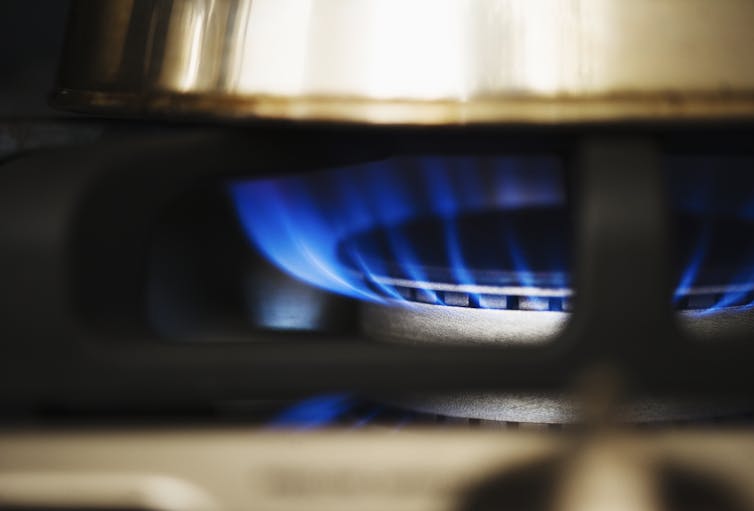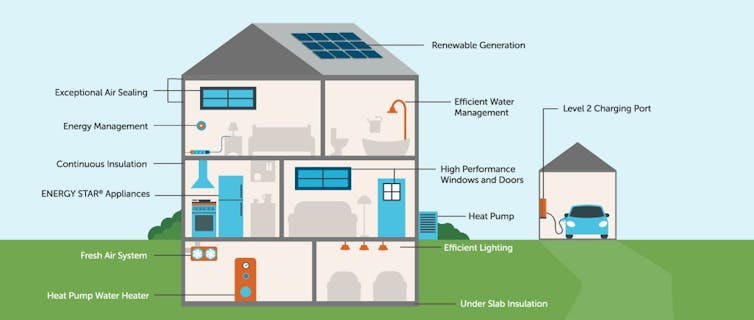Why gas stoves matter to the climate and health
 |
| Industry wants to keep people cooking with gas. Jamie Grill, Tetra Images via Getty Images |
This debate reignited on Jan. 9, 2023, when Richard Trumka Jr., a member of the U.S. Consumer Product Safety Commission, told Bloomberg News that the agency planned to consider regulating gas stoves due to concerns about their health effects. “Products that can’t be made safe can be banned,” he noted.
Politicians reacted with overheated outrage, putting gas stove ownership on a par with the right to bear arms and religious freedom. CPSC Chair Alexander Hoehn-Saric tried to douse the uproar, stating that he was “not looking to ban gas stoves” and that his agency “has no proceeding to do so.” Neither does the Biden administration support a ban, a White House spokesperson said.
Nevertheless, congressional Republicans raced to the barricades, introducing bills with titles like the Guard America’s Stoves (GAS) Act and the Stop Trying to Obsessively Vilify Energy (STOVE) Act.
This skirmish may seem like a tempest in a teapot, but it reveals important contours of the battlefield on which climate politics are waged. As I explain in my book, “Confronting Climate Gridlock: How Diplomacy, Technology, and Policy Can Unlock a Clean Energy Future,” gas stoves matter to climate and to the gas industry because they serve as gateway appliances to the dominant residential uses of natural gas: heating and hot water.
Serious health effects
Direct impacts from gas stoves are a much more urgent concern for human health than for Earth’s climate. Gas stoves are a leading indoor source of nitrogen dioxide, or NO₂, which can cause or worsen respiratory illnesses in people who are exposed to it.
For example, scientific studies show that living in a home with a gas stove increases children’s risk of asthma by nearly one-third and contributes to pulmonary disease in adults.
The climate doesn’t care what fuel we use to cook. Gas stoves account for just 0.1% of U.S. greenhouse gas emissions, even accounting for recent findings of larger than expected household methane leaks. They aren’t a big share of fuel sales either, burning just 3% of the natural gas consumed in homes.
Impeding home electrification
The significance of gas stoves for the climate becomes clearer in the context of the Biden administration’s goal of achieving net-zero U.S. greenhouse gas emissions by 2050. This target can only be achieved by curbing fossil fuel use across the economy, including in homes.
Installing more-efficient furnaces, better insulation and smart thermostats are helpful first steps, but getting close to zero will require switching to electricity for space heating and water heating. In the U.S., 46% of homes use natural gas as their main source of heat, 40% use electricity, 10% use other fuels such as heating oil or propane, and 4% are unheated. For water heating, the percentages are 47% gas, 47% electricity and 6% other fuels.
Today, electric and gas heating have similar carbon footprints, since roughly 60% of U.S. electricity is generated from fossil fuels and many homes use inefficient electric resistance heaters. But the emissions intensity of electricity is rapidly declining as coal plants close and solar and wind power expands.
President Joe Biden has set a goal of 100% clean electricity nationally by 2035. Although current federal policies fall short of that target, a growing number of states have committed to 100% clean electricity by 2050 or sooner.
Natural gas is far harder to decarbonize than electricity. Lower-carbon fuels such as biogas and hydrogen that could be blended in with natural gas are likely to remain scarce and costly.
Furthermore, advanced technologies enable electric heat pumps to heat both air and water far more efficiently than traditional electric or gas furnaces and water heaters. That’s why various scenarios for decarbonizing energy all envision a major shift to electric heat pumps. This transition is well underway in Europe and starting in the U.S.
Replacing existing gas furnaces and water heaters with electric heat pumps can be costly and complicated, though incentives from the Inflation Reduction Act can help. But if new homes are built fully electric from the start, they avoid the cost of installing natural gas hookups, and emit far less air pollution and fewer greenhouse gases throughout the homes’ lifetime.
 |
| This schematic shows key components of a net-zero house that generates as much electricity as it consumes, using renewable energy. Efficiency Vermont, CC BY-ND |
New York City and more than 50 California towns, cities and counties have already banned gas hookups in new buildings. Elsewhere, 20 states have barred the enactment of natural gas bans.
Gas stoves are a big reason why.
The power of a slogan
“Most people don’t care how their water is heated or how their heater works, but the Viking stove in the kitchen, people have this visceral emotional attachment,” Michael Colvin of the Environmental Defense Fund told me in an interview for my book, “Confronting Climate Gridlock.”
That emotional attachment makes stoves a flashpoint in battles over climate policy.
“Cooking is the hill that the gas industry wants to fight on,” Bruce Nilles of Climate Imperative told me in a 2020 interview that foreshadowed the current skirmish. “They’ll say, ‘Do you want the government to take away your gas stove that makes you a great chef?’”
The American Gas Association has promoted the notion that gas stoves make skilled cooks since the 1930s, when it introduced the advertising slogan “Now you’re cooking with gas.”
An AGA executive planted the phrase with writers for comedian Bob Hope. Soon it was picked up by comedian Jack Benny, and even by Daffy Duck. The phrase has also appeared over time in social media endorsements and hashtags.
Gas burners do provide more control than many stoves with electric coils, especially older models, which can be slow to heat up and cool down. Today, however, many chefs, consumers and experts say gas is no longer the obvious choice. Magnetic induction cooktops, which cook using electricity to generate a magnetic field, heat faster, control temperatures more precisely and use less energy than other stoves.
“There’s this big misconception that electric ranges don’t cook as well as gas,” Shanika Whitehurst, a member of Consumer Reports’ research and testing team, said in a recent article. “But the technology has improved to the point where electric and especially induction ranges and cooktops cook every bit as well, if not better than gas.” Consumer Reports ranks induction and some traditional electric stoves among its top-rated models.
Homes built today will endure far beyond Biden’s 2050 net-zero target. And the longer the gas-is-better myth persists, the harder it will be to fully electrify new homes from the start. As I see it, if “cooking with gas” keeps us tethering new homes to natural gas grids for decades to come, our health, climate and wallets will pay the price.![]()
Daniel Cohan, Associate Professor of Civil and Environmental Engineering, Rice University
This article is republished from The Conversation under a Creative Commons license. Read the original article.